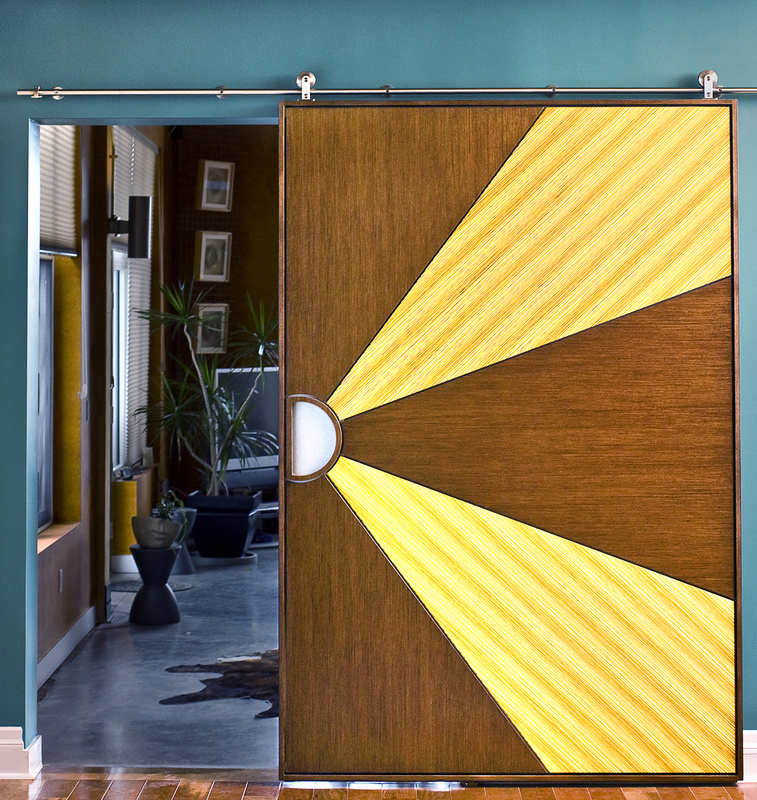KANSAS CITY, Mo. — The urban barn door is sliding into the home front.
Demand for these movable monoliths has grown in recent years as homeowners, including condo dwellers and suburbanites, are looking for solutions with character.
Besides their industrial-chic style — a product of the lofting of America — the sliding doors and hardware serve useful purposes. An everyday hinged door takes up 9 square feet, eating up precious floor space in a hallway or square-foot-crunched condo, points out Jeremy Crowder, vice president of KNC, a third-generation door hardware business in Canada.
“Not only are sliding doors efficient for the homeowner, they’re good for condo developers,” Crowder says.
However, extra wall space is required to the left or right of an urban barn door to accommodate its large size. Ideally, the door should be at least 6 inches wider than the opening. Still, it’s more efficient than a 36-inch swinging door or sets of them.
Hardware is often the priciest part of the indoor sliders, usually starting at about $1,000. A few months ago, KNC introduced the Crowder Round Track, exposed European-style stainless steel with nylon wheels at the top. A barely visible guide-block in the floor helps keep the door on track. All it takes is two fingers to silently and smoothly glide 400 pounds of wood, metal, glass or other material. The hardware is shock-absorbing to keep a residential door from sounding like an authentic hay-holding barn door.
“If you’re entertaining, you want people to remember the party and not the rickety door,” says furniture and product designer Joe Munson of Leawood, Kan., who has created large-scale sliding doors for local clients and others in New York.
Lee Norman of Kansas City, Mo., recently bought the neighboring unit to his River Market condo. The wall between the two loft spaces was removed. Norman wanted the space to be open sometimes, closed others.
” ‘Shut’ is important,” says Norman, chief medical officer at the University of Kansas Hospital. His 28-year-old son, Alex, an architectural designer for solar energy systems, relocated from Southern California to Kansas City and is temporarily living with him. Norman wants him to have privacy. “But he knows they’re both my sides.”
Norman considered pivoting doors and other options. But Rees Michael of North Star Remodel in Kansas City suggested the urban barn door because it acts like a movable wall.
Instead of buying a pre-made door, Norman hired Ryan Bennett and Reid Benson of Dead Leaf Designs in Kansas City to construct a 6-by-8½-foot door. The custom 250-pound door has an industrial plywood-composite core with a zebrawood and wenge veneer. A stainless steel handle and rays accent the exotic woods.
“We thought it should complement his art,” says Bennett, who installed the door earlier this month. Norman worked with native people in Alaska and has regional handcrafts on display, including pieces made with whale and mammoth bone.
Norman considers the door to be the artistic focal point of his home. The hardware cost about $2,200, and the door and installation were another $4,400.
“I’ve never been far from barn doors,” says Norman, who grew up in Adel, Iowa. “Now I live with one.”
Munson made two 8-foot-square sliding metal doors for clients in a Crossroads Arts District loft: They’re barriers to the bathrooms.
The core of each is made of tubular aluminum and medium-density fiberboard. A layer of polyvinyl chloride foam board acts as backing for artwork. The large-scale digital artworks are printed onto vinyl wallpaper, the same type that’s used to put advertisements on freight trucks. One door leads to a guest bathroom, the other to the master bath.
“They’re interactive room dividers,” Munson says. Each of the doors weighs 400 pounds. They don’t lock. The doors are typically open, so if they’re closed, guests know the rooms are occupied.
Kansas City artist Daniel Bartle of Lucid Arts enlarged an image of a pre-1920s Kansas City map and incorporated graffiti-style art and birds for the master bath door. For the guest bathroom, Bartle took a photograph of 18th and Wyandotte streets, an iconic corner in the Crossroads Arts District. He added silhouettes of women in a window, a nod to the nearby Birdies lingerie boutique, as well as discreet monograms, cartoon characters and other elements personal to the residents, Stephen and Sarah Hopkins.
“We continue to notice new pictures and patterns in the artwork that we hadn’t before,” says Sarah Hopkins, senior program manager at Cerner.
The handles are solid chunks of clear, triangular acrylic. Excluding the art, comparable doors with installation cost about $8,500 a piece, Munson says.
“People are becoming savvier to the possibilities of incorporating creative elements to their homes,” Munson says.
Send questions/comments to the editors.


